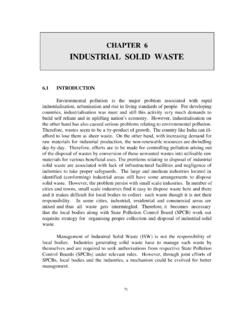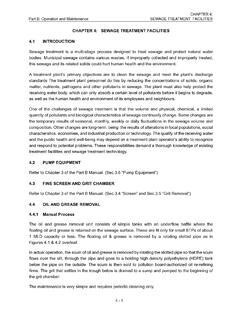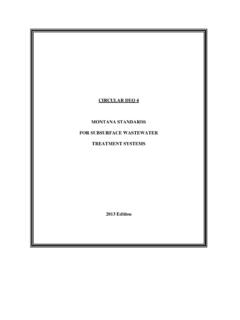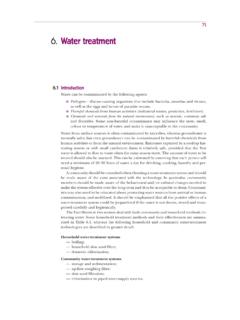Transcription of CHAPTER 5 WATER TREATMENT PLANT - CPHEEO
1 INTRODUCTIONW ater to be supplied for public use must be potable , satisfactory for drinking purposesfrom the standpoint of its chemical, physical and biological characteristics. Drinking watershould, preferably, be obtained from a source free from pollution. The raw WATER normallyavailable from surface WATER sources is, however, not directly suitable for drinking objective of WATER TREATMENT is to produce safe and potable drinking of the common TREATMENT processes used in the past include Plain sedimentation, slow sand filtration, Rapid sand filtration with Coagulation-flocculation units as essentialpretreatment units. Pressure filters and Diatomaceous filters have been used though veryrarely. Roughing filters are used, under certain circumstances, as pretreatment units for theconventional TREATMENT processes may need pretreatment like pre-chlorination and aeration prior toconventional TREATMENT .
2 The pretreatment processes comprising of Coagulation and Flocculationhave been discussed under the main title of Rapid sand filters in para of this CHAPTER . Detaileddiscussion on all such aspects as well as recommended unit operations, is given in the Manualon WATER Supply and TREATMENT (1999 Edition) Ministry of Urban shows typical flow patterns of a Conventional TREATMENT FILTRATION slow sand filter -PLANTIt may include Plain Sedimentation basins followed by the conventional RAPID sand filter PLANTIt can be briefly divided into two main Pretreatment WorksThese include the (1) Coagulation- Flocculation Units with adequate chemical dosingand rapid mixing facilities, and (2) Sedimentation Units to handle the effluent fromthe Coagulation-flocculation OTHER CATEGORIEST here are a number of other categories of filtration plants but not of common use.
3 Of thesePressure filters are used for small TREATMENT plants or industries. Roughing filters may be usedCHAPTER 5 WATER TREATMENT PLANT74to reduce load on the TREATMENT plants. Small streams of WATER in the catchment areas maycarry large particles and floating matter. Introduction of the roughing filters will ensureentrapping of such undesirable material prior to the storage structures of the TREATMENT slow sand PROCESSSlow sand filtration was the first type of porous media filtration used in WATER process is known for its simplicity and the initial operational period of slow sand filters, the separation of organic matterand other solids generates a layer of biological matter on the surface of the filter filter CONTROLSThe pipe work, valves and devices used to regulate the operation of a filter should be properlyplanned.
4 Adequate means must be available to: Deliver raw WATER into the supernatant reservoir, Remove scum and floating matter, Drain off supernatant WATER prior to filter cleaning, Lower WATER level in the bed, Control the rate of filtration and adjust it as bed resistance increases, Ensure that negative pressures cannot occur within the bed (the weir is the deviceusually used for this purpose), Convey filtered WATER to the filter WATER tank, Run filtered WATER to waste or to the inlet side of other filters during the ripeningprocess, Fill sand bed from below with filtered WATER (from other filters) after OPERATIONThe operation of the filter is determined by the filtration rate, which is controlled at the effluentoutlet. Inflow, which may be by gravity from a constant level reservoir, or by a pump, isadjusted so that the head of WATER in the supernatant reservoir remains constant at all raw WATER delivery will cause overflow through the scum outlets, while a reductionin the rate of inflow will cause the level in the supernatant WATER reservoir to drop; eithercondition should alert the operator to a defect in the mechanism controlling the supply ofraw filtration rate is controlled by a single regulating valve on the effluent delivery.
5 At thebeginning of the filter run this will be partially closed, the additional resistance therebyprovided being equal to that which will later build up within the filter bed. Day by day asthe run continues this valve must be checked and opened fractionally to compensate for thechoking of the filter and to maintain a constant filtration rate. In the early part of the filterrun the daily build up of resistance will be almost imperceptible, calling for very little valveadjustment, but towards the end of the filter run the resistance will increase more rapidly,75necessitating a more positive opening of the valve and signalling the impending need for enable the operator to regulate the valve precisely it is necessary to have some form ofmeasuring device on the effluent CONTROL OF ALGAL GROWTHE xcessive algal growth may cause trouble in the operation of open filters.
6 Pretreatment bymicrostrainers is one method of removing the algae contained in the raw WATER . For moredetails please refer to para of this DISSOLVED OXYGENIf the dissolved oxygen content of the raw WATER drops below the potential oxygen demand,anaerobic conditions may develop within the bed. To some extent a reasonable growth ofalgae in the supernatant reservoir oxygenates the supernatant WATER . Where the compositionof raw WATER or climate does not favour the growth of algae, or where chemical dosing orsome other device has been used to remove or exclude them, it may be necessary to useother expedients to increase the dissolved oxygen content, such as aeration of the incomingraw are provided as an integral part of the filter bed. It should be ensured that thesefunction WATER QUALITYS amples of raw and treated WATER will be taken at regular intervals for analysis.
7 In a largewaterworks with its own laboratory, sampling will almost certainly be carried out daily, sincethe effluent analysis constitutes the only certain check that the filter is operating satisfactorilyand the raw WATER analysis provides what is possibly the only indication of a change in qualitythat might adversely affect the efficiency of TREATMENT . In case of small plants with nolaboratory facilities, an attempt should be made to conduct sampling on regular basis. Fieldtesting equipment may be used to measure WATER quality. For more details please refer toChapter 9 of this filter CLEANINGW hile the filter is in operation, a stage comes when the bed resistance increases so much thatthe regulating valve has to be fully opened and it is the right time to plan the cleaning ofthe filter bed since any further resistance is bound to reduce the filtration rate.
8 Resistanceaccelerates rapidly as the time for cleaning approaches. Indicators may be installed showingthe inlet and outlet heads, from which the head loss can be regularly checked; this gives aclear picture of the progress of choking and the imminence of the end of the run. Withoutany measurement of the head loss the only true indicator of build up of resistance is the degreeof opening of the regulating valve, though the experienced operator may be able to recognizepreliminary visual warnings in the condition of the filter bed surface. A slight deteriorationin the effluent quality may be a reason for the need for clean a filter bed, the raw WATER inlet valve is first closed, allowing the filter to dischargeto the clear WATER well as long as possible (usually overnight). As the head in the supernatantreservoir drops, the rate of filtration rapidly decreases, and although the WATER above the bed7677would continue to fall until level with the weir outlet, it would take a very long time to doso.
9 Consequently, after a few hours, the effluent delivery to the clear WATER well is closed,and the supernatant WATER outlet is run to waste through the drain valve the supernatant WATER has been drained off (leaving the WATER level at the surfaceof the bed) it is necessary to lower the WATER within the bed still further, until it is some100 mm or more below the surface .This is done by opening the waste valve on the effluentoutlet pipe. As soon as the Schmutzdecke is dry enough to handle, cleaning should the filter bed is left too long at this stage it is likely to attract scavenging birds that willnot only pollute the filter surface but also disturb the sand to a greater depth than will beremoved by cleaning of the bed may be carried out by hand or with mechanical equipment.
10 Workingas rapidly as possible, they should strip off the Schmutzdecke and the surface sand adheringto it, stack it into ridges or heaps, and then remove the waste material by barrow, hand cart,basket, conveyor belt or other removal of the scrapings the bed should be smoothed to level surface. The quickerthe filter bed is cleaned the less will be the disturbance of the bacteria and shorter the periodof re-ripening. Provided they have not been completely dried out, the microorganismsimmediately below the surface will quickly recover from having been drained and will adjustthemselves to their position relative to the new bed level. In this event a day or two will besufficient for the filter box is refilled, the exposed walls of the supernatant WATER reservoir shouldbe well swabbed down to discourage the growth of adhering slimes and algae, and the heightof the supernatant WATER drain and of the outlet weir must be adjusted to suit the new bedlevel.











